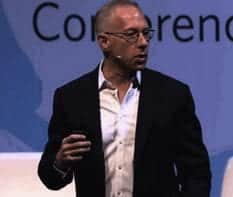S teven Hodas, the former Executive Director for NY city’s iZone or Office of Innovation and current Practitioner in Residence at CRPE.org shares his views on innovation in the face of K-12 bureaucracy.
Dr. Berger: How did you approach innovation, in New York, and the delicate balance between sound investment, public perception and practicality of use for students and teachers with a perceived edict to discover new ways to improve experiences and student outcomes?
Steven Hodas: The easiest point of entry is just to ask the people doing the work (kids trying to learn, teachers trying to teach, administrators administering, parents parenting, etc.) what difficulties they’re encountering and proceed from there. One of the biggest mistakes in the way we do “school” (and government in general) is allowing the people at the top to believe they can understand and speak for the people closest to the actual work, and this is no less true for work called “innovation.” 
Going directly to those closest to the work at the very outset makes it more likely you’ll be working on a real problem in an authentic way. From there, if you help everyone to keep an open and humble mind while opening the doors to non–traditional solutions and providers and iterating along the way, you’ll almost always end up with something better then what was in place before.
DB: What lessons learned were fairly expected and which ones were surprises to you that would impact your approach in the future?
SH: I expected that that there would be a huge pent–up demand on the part of practitioners (including central office bureaucrats) for new ways of going about their work and that was certainly the case. There really weren’t any surprises: the buy–in and pushback were fairly predictable if you were familiar with how people think about their work and what is rewarded in large organizations.
DB: I’m glad you brought up “reward” systems in large organizations. How can education leadership harness change if the very foundation of the career ladder, in this industry, is predicated on consistency and tradition? Does the proverbial white flag need to be cast overhead marking a new day in education where innovation is rewarded and risk is not avoided but understood in the context of change for the better?
SH: That’s the core of what needs to change. People take their cues from their leaders, so if a school board and superintendent model smart risk–taking, transparency, empathy, and the difference between “responsibility” and “blame” (which are the key ingredients of innovation) that’s what you’ll get in your district. Rewards don’t have to be financial: I think people would much prefer a stimulating, problem–solving work environment and to be acknowledged for their initiative (especially when it doesn’t turn out as hoped) than to receive some token monetary reward.
DB: Can education, as a public entity, shed its proverbial skin of labels like, “antiquated and outdated” when contextualizing its ability to innovate in a timely way, within budget for real-time results that move the needle for both students and teachers?
SH: It’s certainly possible in theory, though it will never look like innovation in the private sector, where there is a lot more incentive to try to improve things and more shared understanding even of what “improvement” might look like. Even so, I think most of what it takes to make for greater dynamism at all levels of the system (lately I prefer the word “dynamism” to “innovation”) is to remove constraints on practitioners and encourage people’s inborn desire to tinker with the tools and conditions around them. In other words, simply encouraging individuals to risk trying new things and then spreading the word about what works and what doesn’t gets you pretty far down the road. 
DB: Should we continue to swim up stream against procurement processes, budgetary constraints and federal and state wrangling or is there an alternative way to ensure students and teachers are in innovative environments that build competency and confidence?
SH: Yes, I believe we should continue to swim upstream, to make the stream by paddling, to be the fish we want to see in the world. Seriously though, I’m not a big fan of opting out of or evading stupid impositions if there’s any possibility that by engaging with them imaginatively and constructively you can fix them a little bit. In government, since you can’t have disruption in the conventional Christensen sense of it you really do need to work on the stuck machine if you want things to change for most people. I certainly believe in giving people alternatives (like charters) but I also really want to fix the dominant provider itself.
DB: One final and very broad question. Now that you can look back on your experiences in New York do you think that our approach to training education leaders should focus more on practical methods to successfully deploy innovation in schools so that administrators feel better equipped to evaluate technology merits, broker collaborations between their schools and industry and navigate the messaging of these efforts?
SH: Absolutely, for me this is at the heart of why all the trying of new things over the past fifteen or more years hasn’t led to dynamic districts or practices at scale. Quite the opposite, we’ve had plenty of examples of new policies (data systems, tablet deployments, Common Core to some extent) that have wrecked on the shores of of district practices. It’s not so much that schools do the wrong things but that they do things wrongly, and this I believe is because most leaders don’t want to get their hands dirty with the Operating Systems of districts like procurement, contracting, IT, HR, etc. But unless you get those right it really doesn’t matter what your policies are because it’s through those arcane, non–sexy functions that policy gets made real.
_______________________________________________________________________
Please connect via LinkedIn and Twitter to suggest interview guests and story ideas. If you are the idea you want to float by all means connect and pitch me your perspective!
______________________________________________________________________
 Steven Hodas continues to provide unique perspectives to a clamoring audience of education leaders and innovators desperate to reinvent public education in the U.S. Hodas most recent post as Executive Director for NY city’s iZone or Office of Innovation within the department of ed provided a path lit with promise sadly undone by the political machine. Hodas is currently Practitioner in Residence at CRPE.org. Hodas’s background that reaches behind the walls at NASA to the front lines of the IPO world brought fresh perspectives to those wanting to crack the procurement code and instill cutting edge technology in schools (also see Hodas speech below).
Steven Hodas continues to provide unique perspectives to a clamoring audience of education leaders and innovators desperate to reinvent public education in the U.S. Hodas most recent post as Executive Director for NY city’s iZone or Office of Innovation within the department of ed provided a path lit with promise sadly undone by the political machine. Hodas is currently Practitioner in Residence at CRPE.org. Hodas’s background that reaches behind the walls at NASA to the front lines of the IPO world brought fresh perspectives to those wanting to crack the procurement code and instill cutting edge technology in schools (also see Hodas speech below).
The following interview was originally published on Scholastic District Administrators “Down the Hall” column.
